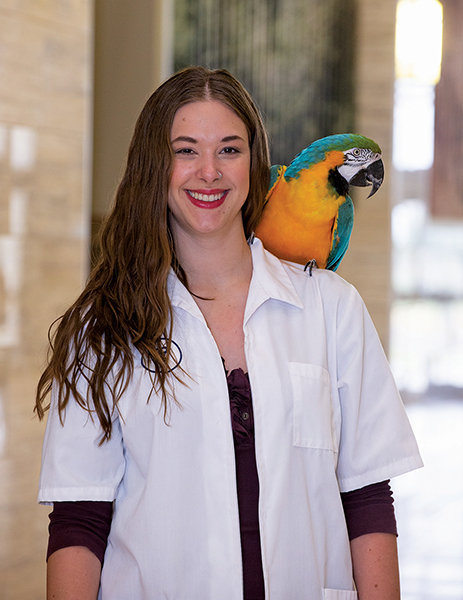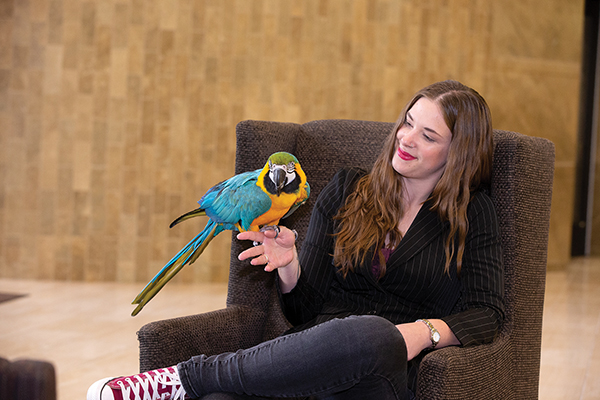The Sky’s The Limit
Story by Megan Myers, CVMBS Communications

Jillian Villalva has always been fascinated with birds.
“As a kid, my parents would lose me when we were walking places because I would see some bird and want to follow it to figure out what it was doing,” said the fourth-year veterinary student.
Growing up in Portland, Oregon, the force that drew her to nature also instilled in her a love for all animals, and especially exotic birds, which have always held a special place in her heart.
“My grandfather was a woodsman and was really fascinated by birds,” she said. “I would go out walking with him and he would tell me about all of the different species; he knew all of them.
“Birds always just felt magical to me,” Villalva said. “They’re flighty and weird and you have to be quiet and sneak up on them, so when you get to be near one, you feel privileged, because it’s not something that people normally get to do. You feel very special when you work with them.”
When she decided to pursue her childhood dream of becoming a veterinarian, a career in avian medicine was the obvious choice.
Birds and other exotic animals typically require a sensitive touch and precise care to remain happy and healthy as pets. The veterinarian caring for these animals must understand the uniqueness of each species and know how to recognize the slightest changes in appearance or behavior.
“It’s just a completely different mindset of how you approach your patients,” Villalva said. “I like paying attention to the really tiny details and the long conversations that you end up having with owners.
“Exotic medicine is about connecting with the person and getting them on the right page, being excited about what they’re doing and happy because they feel like they know how to understand or bond with their animal,” she said. “That’s what makes me feel really fired up about medicine.”
To begin working toward a career in exotic medicine, Villalva studied ecology and conservation biology for her undergraduate degree at Boston University. She then moved south to Texas to be near her husband’s family and begin her veterinary education at Texas A&M.
In her third year as a veterinary student, Villalva had the opportunity to attend an educational abroad trip with CVM associate professor Dr. Donald Brightsmith. They traveled to Peru to continue his ongoing research on the scarlet macaw, a species that is experiencing declining numbers in the wild.
Brightsmith’s research focuses on macaw chick-rearing behavior, with an emphasis on finding ways to improve chick survival rates. Mother macaws typically lay multiple eggs over a period of time but only care for the chick that hatches first because it is the largest.

Through previous studies, Brightsmith discovered that by removing a chick and rearing it by hand, it could then be translocated to a different nest with a chick of the same size. After several days, the mother macaw would accept the new chick and begin feeding it along with her own chick.
As a veterinary student, Villalva was interacting directly with the chicks to assess their health, take measurements, and track their growth.
“It was the coolest thing I’ve ever done,” she said. “We walked around the jungle, climbed 100- to 150-foot trees in the Amazon, and played with baby macaws.
“I really loved the collaboration between all of the scientists there, because everyone was coming from a different background with slightly different focuses,” she said. “It was this huge collaboration of minds all coming together to solve problems and think about things critically.”
After graduation, Villalva plans to begin a practice route specialization in avian and exotic medicine. This method of specialization involves writing case reports while working in a clinic, and then submitting those reports for a chance to take an exam for board certification.
She then plans to open her own clinic somewhere in Texas and spend every day caring for the birds and other exotic animals she loves.
“Texas is so unique in that it has this private sector of exotic medicine,” Villalva said. “With most places in the rest of the country, when you want to do exotics, you have to do public medicine—at a zoo, a rehab center, or something that’s run by the state—so the medicine is really different.
“When I came here, I was excited to see opportunities in private exotic medicine that had the patients I’ve loved forever and the type of medicine that I love,” she said.
With a strong passion for such a unique area of veterinary medicine, Villalva is sure to have an exciting career ahead of her full of the animals she has been fascinated with for her entire life.
###
Note: This story originally appeared in the Spring 2020 edition of CVM Today.
For more information about the Texas A&M College of Veterinary Medicine & Biomedical Sciences, please visit our website at vetmed.tamu.edu or join us on Facebook, Instagram, and Twitter.
Contact Information: Jennifer Gauntt, Director of Communications, Texas A&M College of Veterinary Medicine & Biomedical Sciences; jgauntt@cvm.tamu.edu; 979-862-4216


